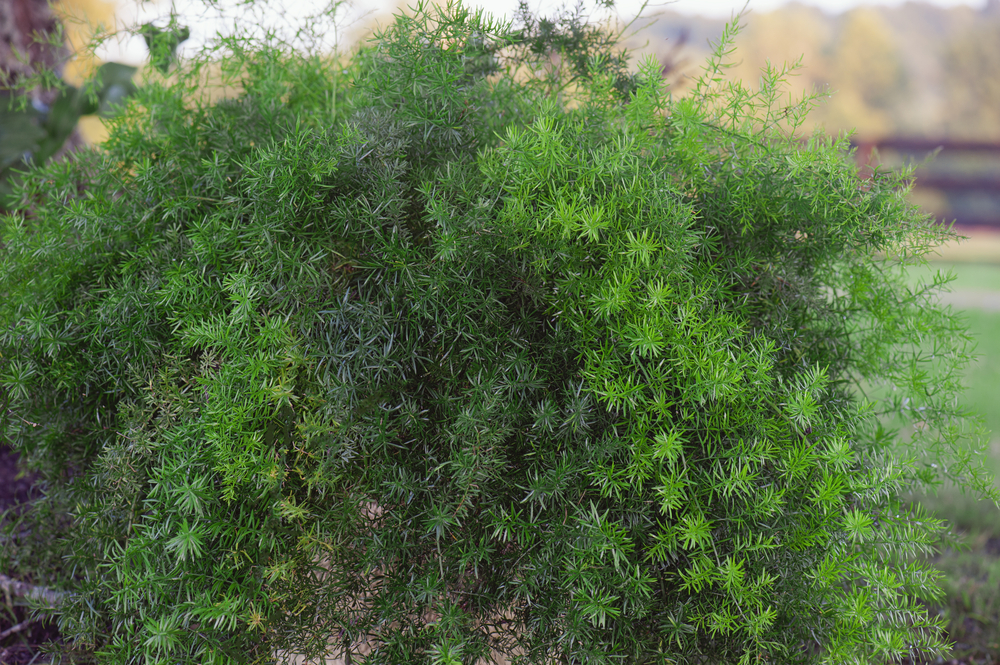HousePlantJoy is supported by our audience. When you purchase through one of our links, we may earn a small affiliate commission. As an Amazon Associate I earn from qualifying purchases. Your cost is not affected.
==================
With the feathery-like foilage, this plant might seem difficult to maintain. But when you know what it needs, asparagus fern care need not be difficult at all. In fact, they can be easy keepers.
The Ultimate Guide to Asparagus Fern Care:
Keep Your Plant Thriving
Asparagus ferns are a popular choice for indoor and outdoor gardening. Their lacy, fern-like foliage is beautiful. And they are easy to maintain. However, many people struggle with keeping their asparagus ferns healthy and thriving. In this ultimate guide to asparagus fern care, I will share with you everything you need to know to keep your plant healthy and lush.
Asparagus Fern (large)
Introduction to Asparagus Fern
Known as Asparagus Densiflorus, they grow wild in South Africa. Although they don’t look like one, they are a member of the Lily family. Their thin, wiry stems grow up to 2-3 feet long. The delicate, needle-like leaves grow in clusters. Asparagus ferns produce small white or pink flowers in the summer, followed by small red berries. Asparagus ferns make beautiful houseplants. But they can also be planted outdoors in warm climates.
Benefits of Having an Asparagus Fern
Aside from their aesthetic appeal, asparagus ferns have health benefits. Known for their air-purifying qualities, they help remove harmful toxins from the air and improve air quality. Additionally, asparagus ferns and other houseplants help to reduce stress and anxiety by creating a calming environment. They are also low-maintenance plants that require minimal care, making them a great choice for busy individuals.
Common Types of Asparagus Fern
There are several common types of asparagus ferns. Each sports its own unique characteristics. The most popular varieties include:
‘Sprengeri’ Asparagus Densiflorus – Sprengeri has long, trailing stems and delicate, needle-like leaves.
‘Myers’ Asparagus Densiflorus – Myers has thicker, more robust stems and larger, more substantial leaves.
‘Myersii’ Asparagus Densiflorus – Meyersii, a subvariety of Myers, has a more compact growth habit and thicker stems than the other varieties.
Asparagus Fern Care: Light and Temperature Requirements
Asparagus ferns thrive in bright, indirect light. They can tolerate some direct sunlight, but too much can scorch their delicate leaves. If possible, place your asparagus fern near a north or east-facing window where it can receive bright, indirect light for several hours a day.
Asparagus ferns prefer warm temperatures between 60 and 75 degrees Fahrenheit. They can tolerate cooler temperatures, but they will not grow as quickly or as vigorously in cooler temperatures.
Watering and Fertilizing
Asparagus ferns require regular watering to keep their soil moist but not waterlogged. Water your asparagus fern thoroughly once a week, allowing the soil to dry out slightly between waterings. Be sure to use a well-draining potting mix to prevent water from accumulating in the soil.
Fertilizing your asparagus fern will help to promote healthy growth and lush foliage. Use a balanced, water-soluble fertilizer once a month during the growing season (spring and summer). Do not fertilize your asparagus fern during the winter months, as this is their dormant period.
Foxtail fern, Asparagus Densiflorus,
Pruning and Propagating
Pruning your asparagus fern helps to promote bushier growth and prevent it from becoming too leggy. Use sharp, clean scissors to trim back any dead or yellowing leaves, as well as any overly long stems. You can also pinch back the tips of the stems to encourage branching.
Propagating your asparagus fern is a great way to create new plants from your existing one. To propagate your asparagus fern, simply divide the plant at the root ball and plant each division in its own pot. Alternatively, propagate your asparagus fern using stem cuttings. Simply cut a stem from your plant and place it in a pot of moist soil. Keep the soil moist and wait for new growth to appear.
Pests and Diseases That Can Affect Your Asparagus Fern
Asparagus ferns are relatively pest and disease-resistant, but they can still be affected by a few common issues. Spider mites and mealybugs are the most common pests that can affect asparagus ferns. These pests can be controlled using insecticidal soap or neem oil.
Root rot is a common disease that can affect asparagus ferns if they are overwatered or planted in soil that does not drain well. To prevent root rot, be sure to use a well-draining potting mix and allow the soil to dry out slightly between waterings.
Asparagus Fern Care Tips and Tricks
- Use a pebble tray to increase humidity around your asparagus fern.
- Rotate your asparagus fern periodically to ensure even growth.
- If your asparagus fern is not growing well, try moving it to a different location with more or less light.
- Do not allow your asparagus fern to become too dry or too wet, as this can lead to stress and damage.
Enjoying Your Healthy and Thriving Asparagus Fern
Asparagus ferns offer a beautiful addition to any home or garden. And they require only basic care and maintenance. By following the tips and tricks outlined in this ultimate guide to asparagus fern care, your plant grows healthy and thrives for years to come. Remember to provide your asparagus fern with bright, indirect light, regular watering and fertilizing. It also needs occasional pruning to keep it looking its best. With proper care, your asparagus fern will reward you with lush, green foliage and a calming, stress-free environment.
Video Credit: @LSUAgCenter
Master Asparagus Fern Care: Grow and Care for this Versatile Houseplant
The asparagus fern is a beautiful and versatile houseplant that can bring a touch of greenery to any indoor space. With its delicate, feathery foliage and easy-to-care-for nature, it’s no wonder that it’s become a popular choice among plant enthusiasts.
We hope that this ultimate guide has given you all the information you need to successfully grow and care for your own asparagus fern. From choosing the right pot and soil to providing the right amount of light and water, we’ve covered all the basics.
But there’s always more to learn about plant care, and we invite you to continue your journey with us by checking out our next blog post. We’ll be diving into even more plant care tips and tricks that will help you keep your houseplants happy and thriving for years to come. So, stay tuned and happy gardening!
Quick FAQ
What is an asparagus fern plant?
The asparagus fern plant, also known as Asparagus setaceus or Asparagus plumosus, is a popular houseplant that belongs to the family Asparagaceae. Despite its name, the plant is not a true fern, but rather a member of the asparagus family.
What are the care requirements for asparagus fern plants?
Asparagus fern plants require bright, indirect light and well-draining soil. They prefer slightly moist soil but can tolerate some dryness between waterings. The plant should be fertilized with a balanced houseplant fertilizer once a month during the growing season, which is in the spring and summer.
What are the different types of asparagus fern plants?
There are several types of asparagus fern plants, including Asparagus setaceus, Asparagus plumosus, Asparagus Densiflorus, and Asparagus Falcatus. Each type has its unique characteristics, such as leaf shape, size, and texture.
How often should I water my asparagus fern?
Water your asparagus fern thoroughly once a week, allowing the soil to dry out slightly between waterings.
Can asparagus fern plants be grown outdoors?
Asparagus fern plants grow native in South Africa and commonly grow outdoors in warmer, subtropical climates. In colder regions they grow as annual plants but need protection from frost and extreme cold.
What are the benefits of having an asparagus fern plant?
Asparagus fern plants are not only visually appealing but also have air-purifying qualities. They help to improve indoor air quality by absorbing pollutants such as formaldehyde, benzene, and xylene.
How do you propagate asparagus fern plants?
Asparagus fern plants propagate through division or stem cuttings. To propagate by division, gently separate the plant’s root system into two or more clumps and replant in separate pots. To propagate by stem cuttings, take a cutting of the stem with a few leaves attached, dip the end in rooting hormone, and plant in moist soil.
How big do asparagus fern plants grow?
Asparagus fern plants often grow up to three feet tall and three feet wide. With proper care, the plant can remain small and compact, making it suitable for smaller spaces such as apartments or offices.
How often do asparagus fern plants need to be repotted?
Asparagus fern plants only need to be repotted every two to three years, depending on their size and growth rate. The best time to repot is in the spring when the plant is actively growing. Choose a pot that is one to two inches larger than the current pot, using fresh soil to promote healthy root growth.
How does an asparagus fern plant look like?
Asparagus fern plants have long, feathery stems that can grow up to several feet long. The stems are lined with small, needle-like leaves and small white or pink flowers that bloom in the summer.
Is an asparagus fern plant toxic to pets?
Yes, asparagus fern plants are toxic to both dogs and cats. The toxic agent, sapogenin, is a steroid found in a variety of plants. If a dog or cat ingests the berries of this plant, vomiting, diarrhea, and/or abdominal pain can occur. Keep your pets away from the plant and seek veterinary attention if ingestion is suspected.
What should I do if my asparagus fern is not growing well?
Try moving your asparagus fern to a different location with more or less light, and make sure it is not becoming too dry or too wet.
What are some common pest problems for asparagus fern plants?
Asparagus fern plants are susceptible to spider mites, mealybugs, and scale insects. Regular inspections and proper care can help prevent infestations. If pest problems do arise, treat promptly with an appropriate insecticide.
You Might Also Like






